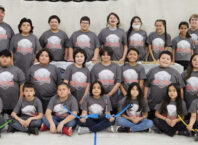By Eddie Chuculate
Although American Indian schools in Minneapolis are awaiting a state mandate on reopening this fall amid the coronavirus pandemic, a consensus is that distance learning will continue in some form – at least initially.
Minn. Gov. Tim Walz is expected to announce measures in late July that will have schools either reopening fully, continuing with distance learning or a hybrid of the two.
But the Bdote Learning Center has already decided to begin its new quarter July 29 with distance learning – the same way it ended the previous quarter June 4 after the pandemic forced a statewide closure of schools in March.
Although Bdote, which serves around 115 kindergarten through eighth-grade students, is a charter school and its own district, it must either abide by any state mandate or enact even stricter measures for kids’ safety, said director Cindy Ward-Thompson, 44.
Therefore, without much of a leeway in advance of a state ruling, the decision was made to continue with online classes. Adjustments could possibly be made later in the school year, Ward-Thompson said.
“We’ve got kids in families that are in the top tier of risk” for the coronavirus, Ward-Thompson said, “and a lot of our families are multigenerational with a lot more (susceptible) elders than other schools.”
Bdote, at 3216 E. 29th St., serves mainly Dakota or Ojibwe children from all over the Twin Cities metro area, including Minneapolis, St. Paul, Shakopee and Andover, Ward-Thompson said.
The school’s first go at distance learning was not without some problems, including lack of computer knowledge or equipment and advice at home.
“In some instances, say, you’d have a kindergartner with a great-grandma without a lot of knowledge about computers trying to help out,” said Ward-Thompson, the director since 2016 and a Bdote founder.
To combat that, she said, teachers will try to meet with students at least once a week in the library or outside “just to lay eyes on the kids and have that physical contact. Not being able to see them in person has been really hard. We miss the kids so much,” she said.
Another factor for continuing online studies is the fact some families have members who already have COVID-19, she said.
“Once you get that spread into Little Earth [Little Earth of All Tribes, a densely populated Native housing in south Minneapolis], you have problems,” Ward-Thompson said.
She said staff will provide daily activity kits that keep students busy in other ways.
“We’re trying to give a balance that has them walking or biking outside – not just on the computer all day,” Ward-Thompson said.
“Our biggest chore has been (access to) the internet and making sure kids hang on to their devices,” she said. “We’ve been providing hotspots and paying for internet in some cases or trying to get them hooked up with other (Wi-Fi) services.”
The Minnesota Department of Health provides a list of suggested anti-virus precautions for staff and students on its website, including PDFs of safety posters to hang for kids.
At Takoda Prep, which serves primarily Native students at the American Indian OIC at 1845 E. Franklin Av., coronavirus safety guidelines are already in place for the new semester, which would begin Sept. 8 – the day after Labor Day.
AIOIC chief executive officer Joe Hobot (Standing Rock Sioux) said the school already has protective materials in place for in-person study like plexiglass shielding in key areas, a wide distribution of hand sanitizer, digital temperature scanning for all students and visitors and social-distancing markers with colored tape.
He said the school, which has a capacity for 45 ninth through twelfth-graders but may enroll between 70-80 during the school year, also has an isolation room for people who may be infected with the virus and a contact-tracing program in place.
Students or staff who contract the disease can’t return to school for at least 10 business days until they become noncommunicable.
Since the facility itself is small, Hobot said, staff can disinfect hourly with hospital-grade disinfectant, hitting high-touch surfaces such as doorknobs and light switches regularly.
Hobot says since Takoda is part of Minneapolis Public Schools, it abides by district policy and is ready for what will likely be a hybrid approach this fall.
The basic approach would be to alternate groups of students who stay home on some days with others who come to the school.
His main gripe is what he sees as an overblown reliance on distance learning as an educational savior during the pandemic.
“Distance learning is a euphemism,” Hobot said. “More accurately, it’s home-schooling. You have visions of teachers and prepared video lessons and that’s certainly not occurring.
“It’s just double-duty for parents, many of whom are working multiple shifts and they’re at a loss to provide adequate time to be a teacher, too. It’s just burdensome and not a quality education. Say you’re a parent with four kids in four grade levels. Where’s the time?” he said.
Hobot said the state Department of Education “passed the buck.” “Email the curriculum and maybe you watch a YouTube video. Even then if you have follow-up questions, where does that student turn to?”
Hobot said Takoda ran into problems initially last semester after the shutdown.
“It wasn’t really working for us. There was this big digital divide. Some (Native) community members don’t have the computers or dependable access to Wi-Fi or they have to rely on public accommodations.
“A lot didn’t get Chromebooks or tablets until it was too late. Not having the technology at hand puts you back. We were kind of upset. And the Department of Education plays it like it’s this great solution when it’s not.”
https://bdote.org
https://www.health.state.mn.us/diseases/coronavirus/schools
https://www.health.state.mn.us/diseases/coronavirus/schools/clean.html
https://www.health.state.mn.us/diseases/coronavirus/schools/supplies.html
https://education.mn.gov/MDE/dse/health/covid19







